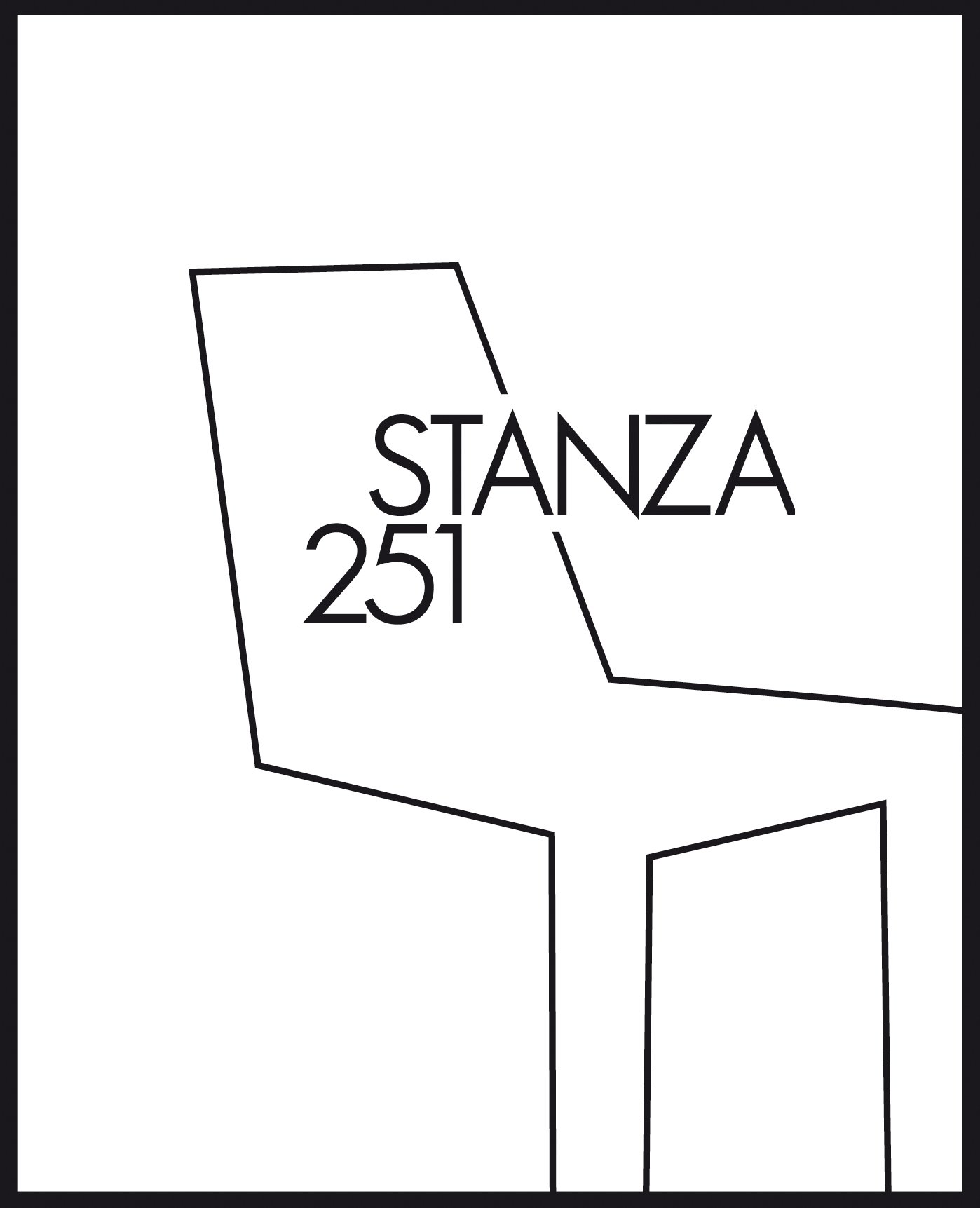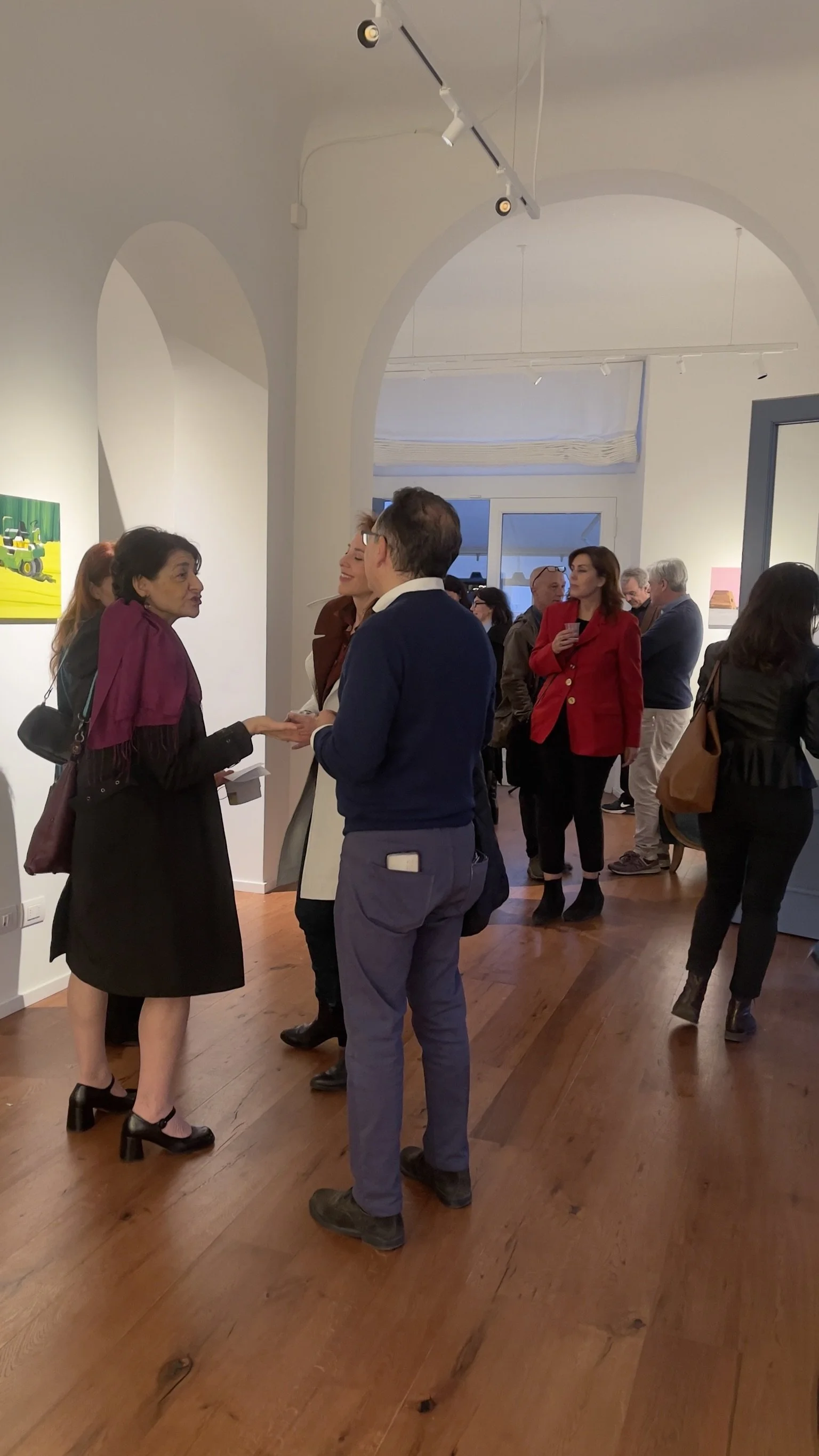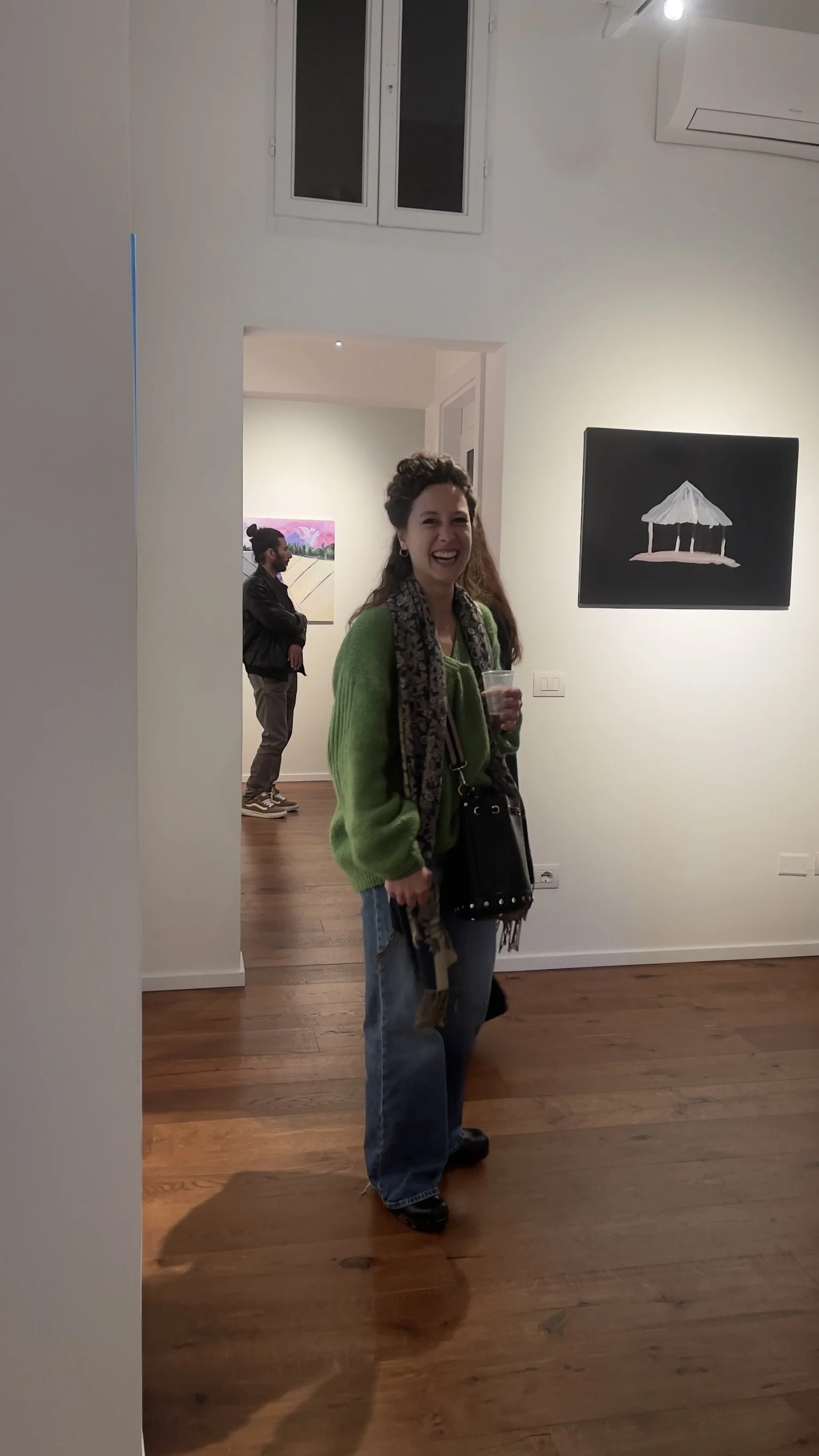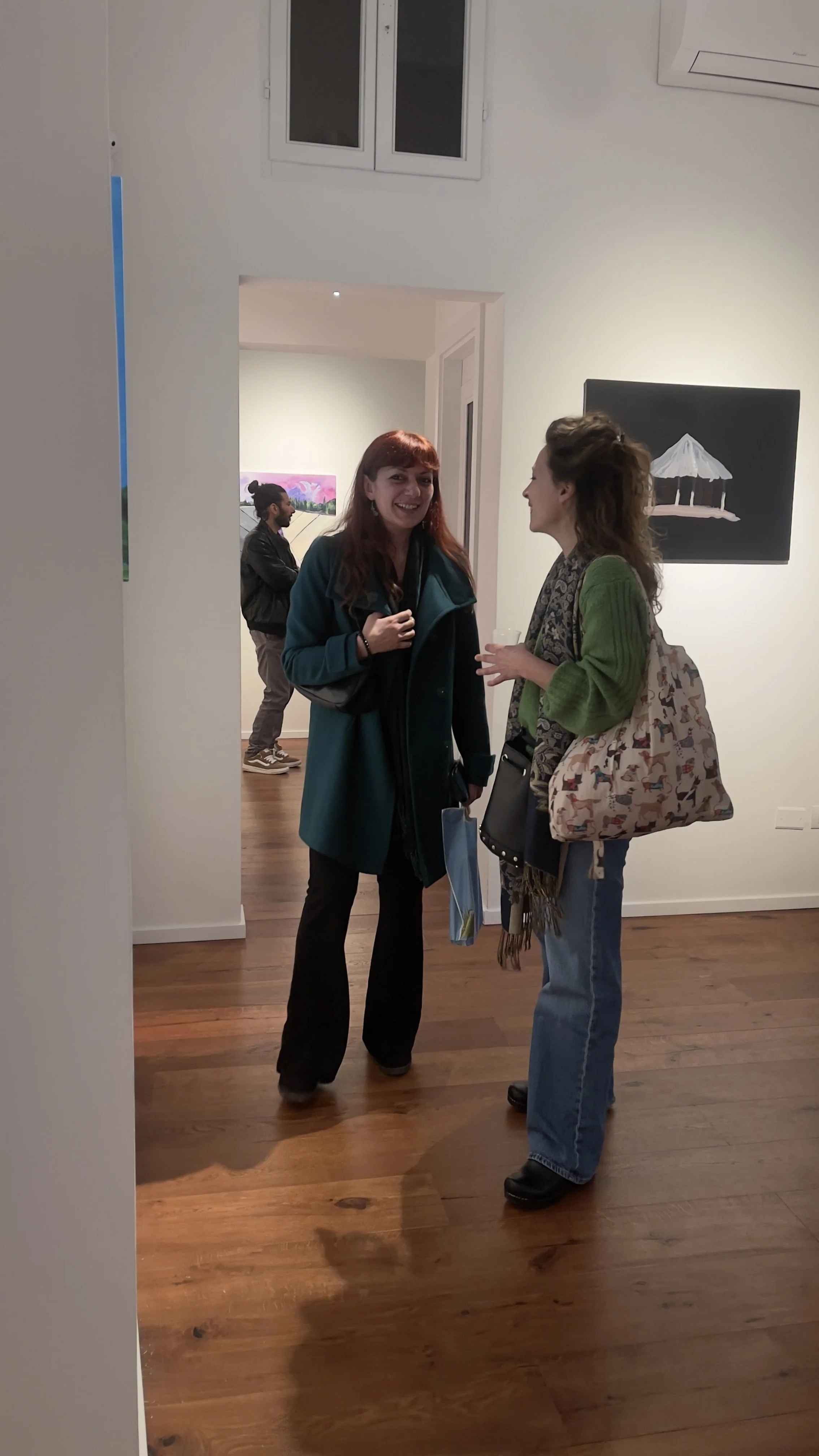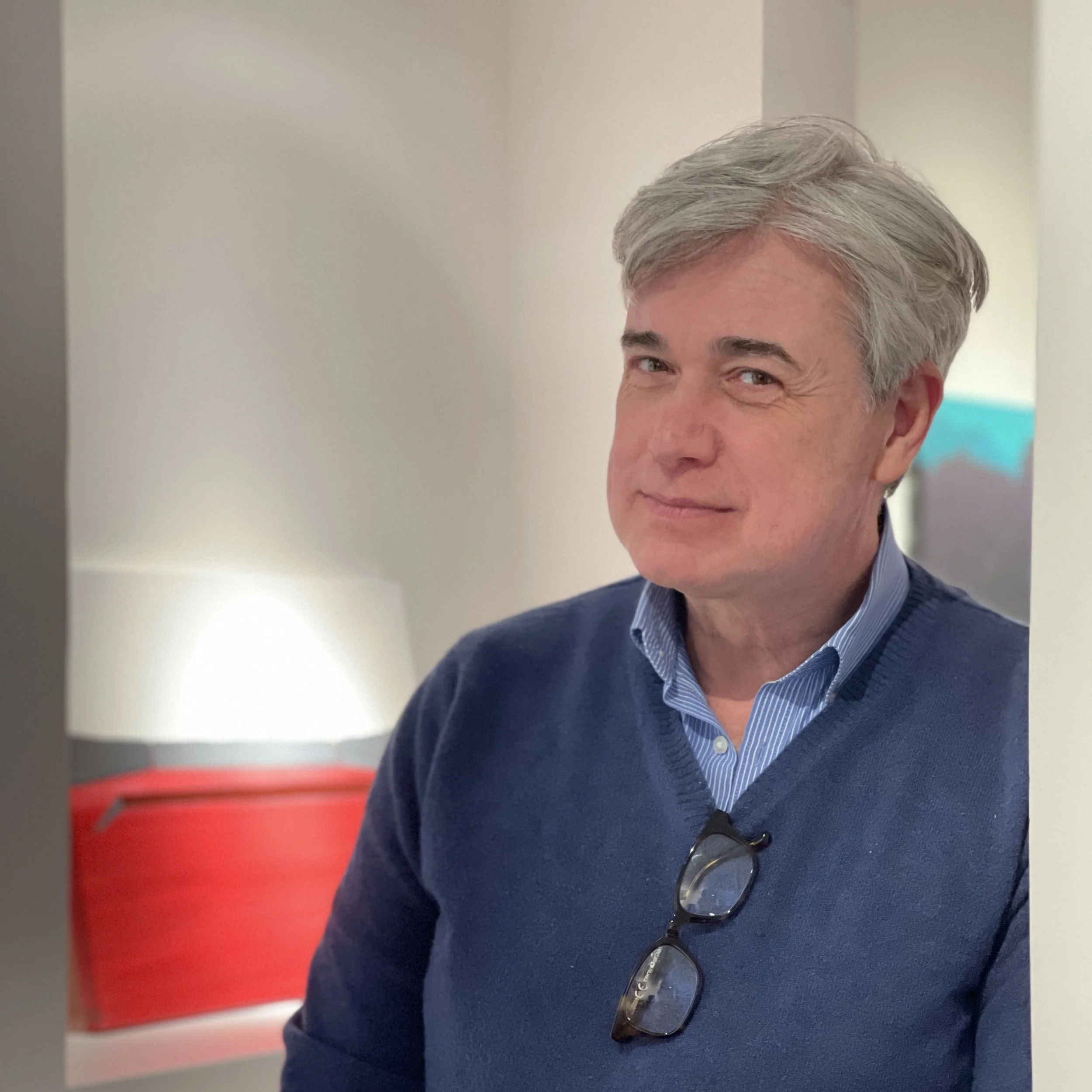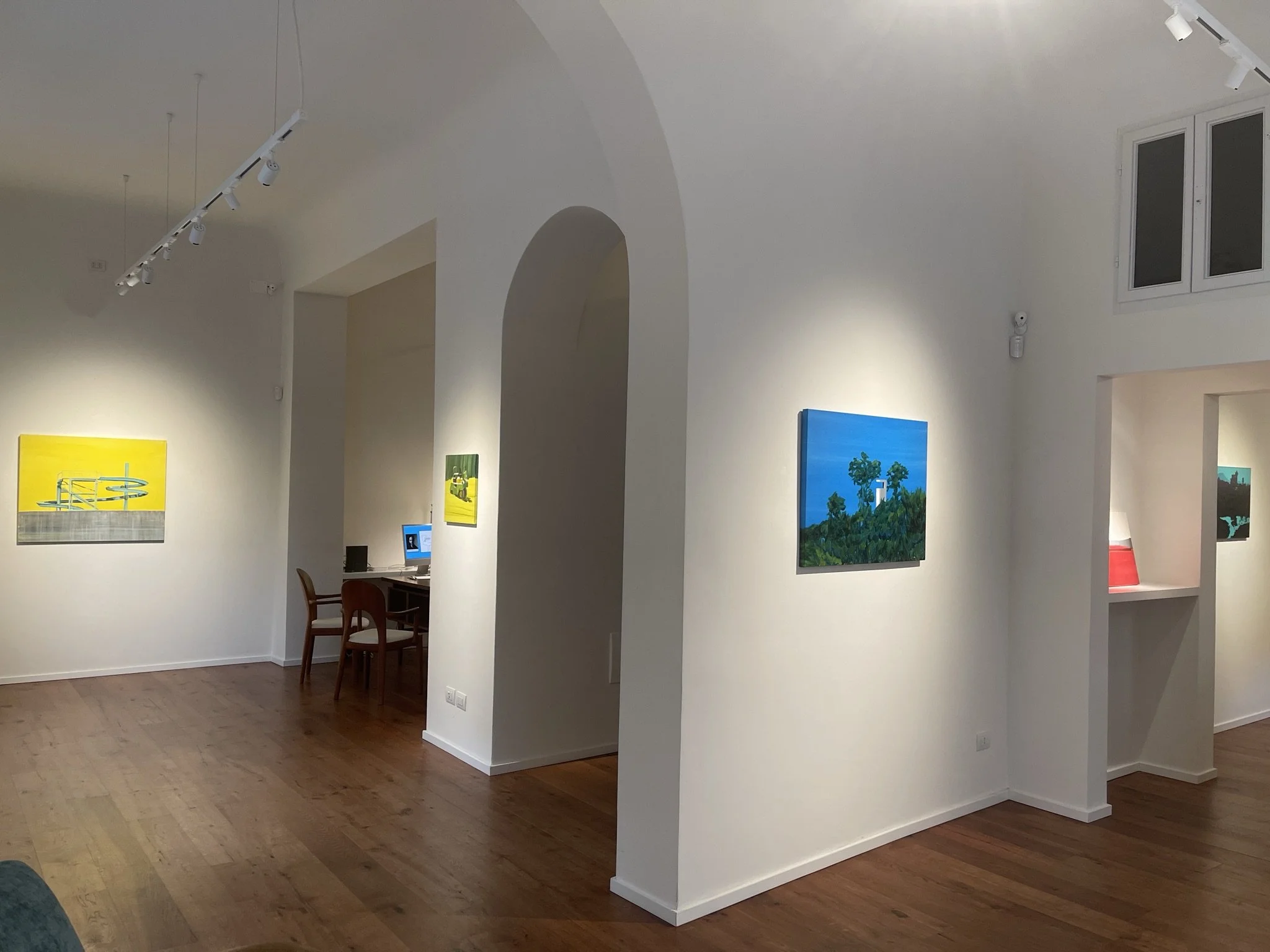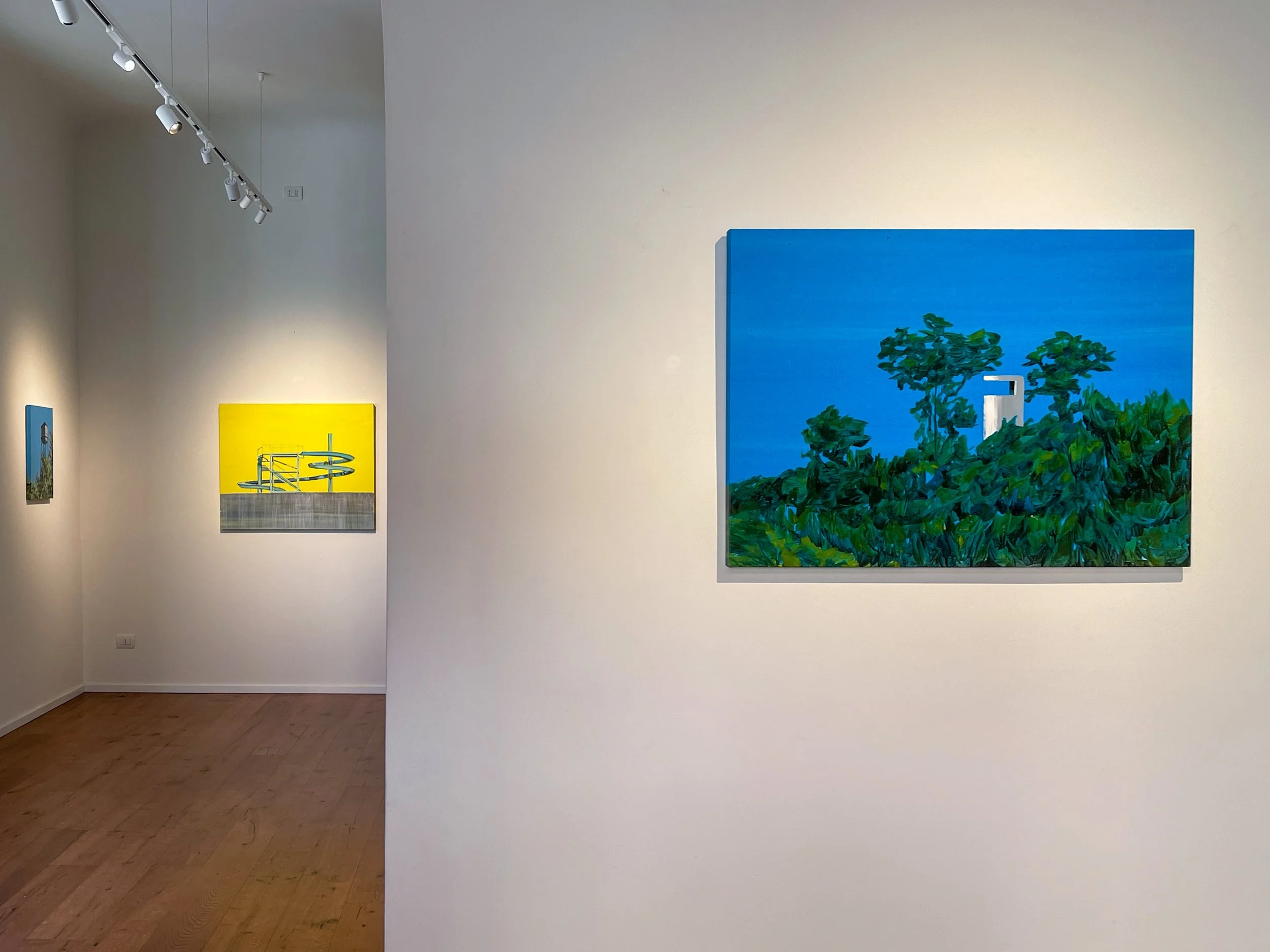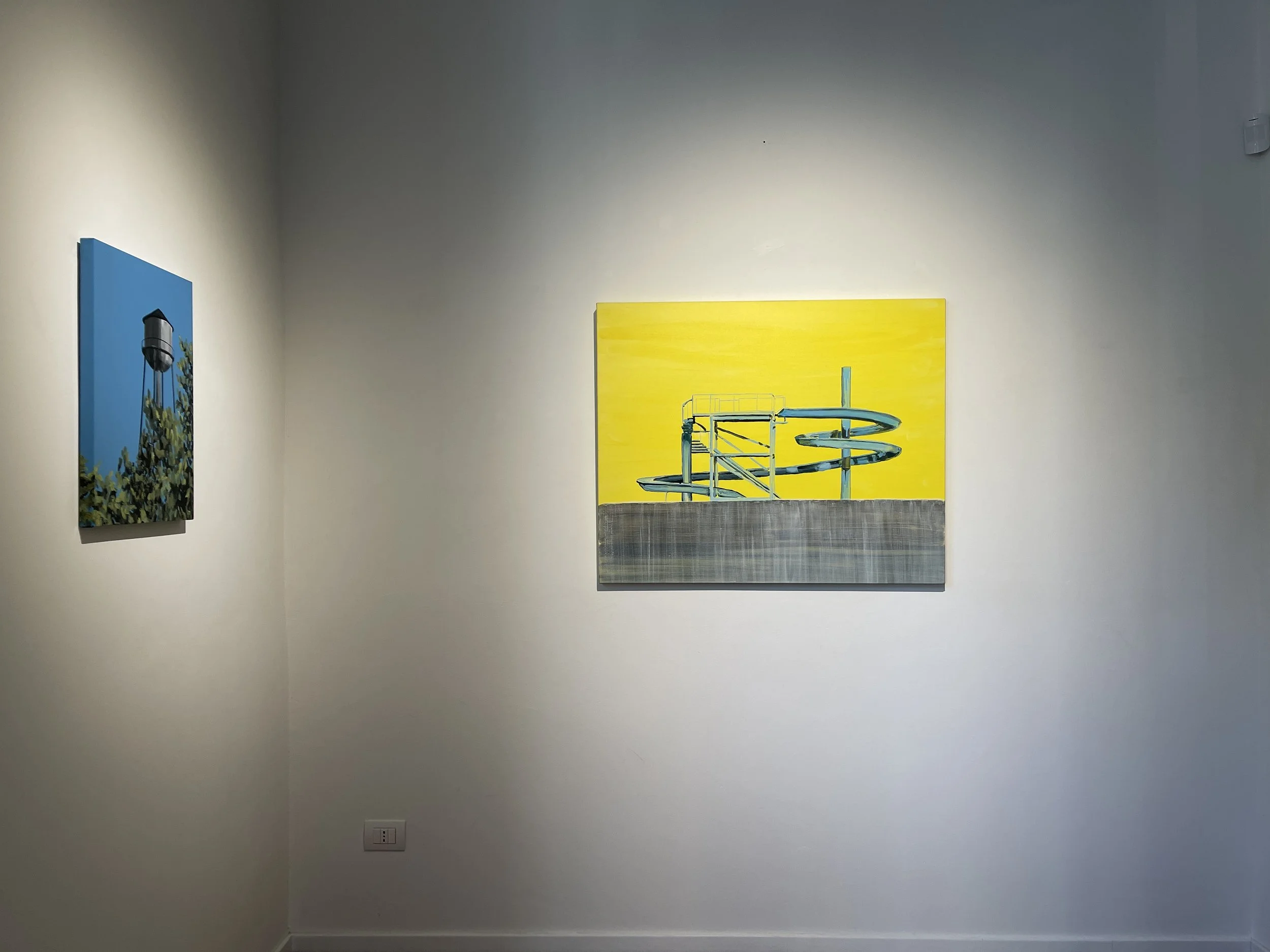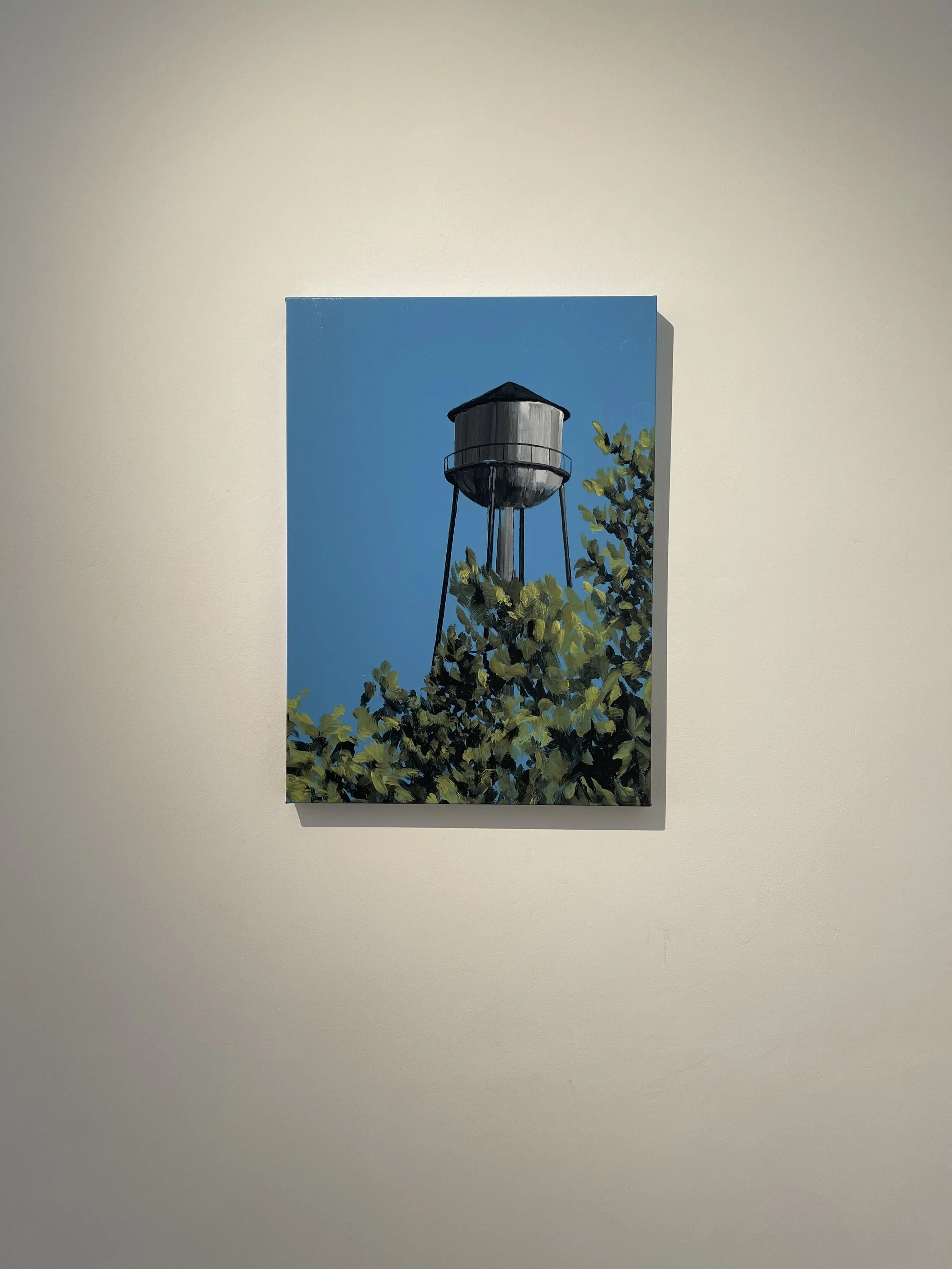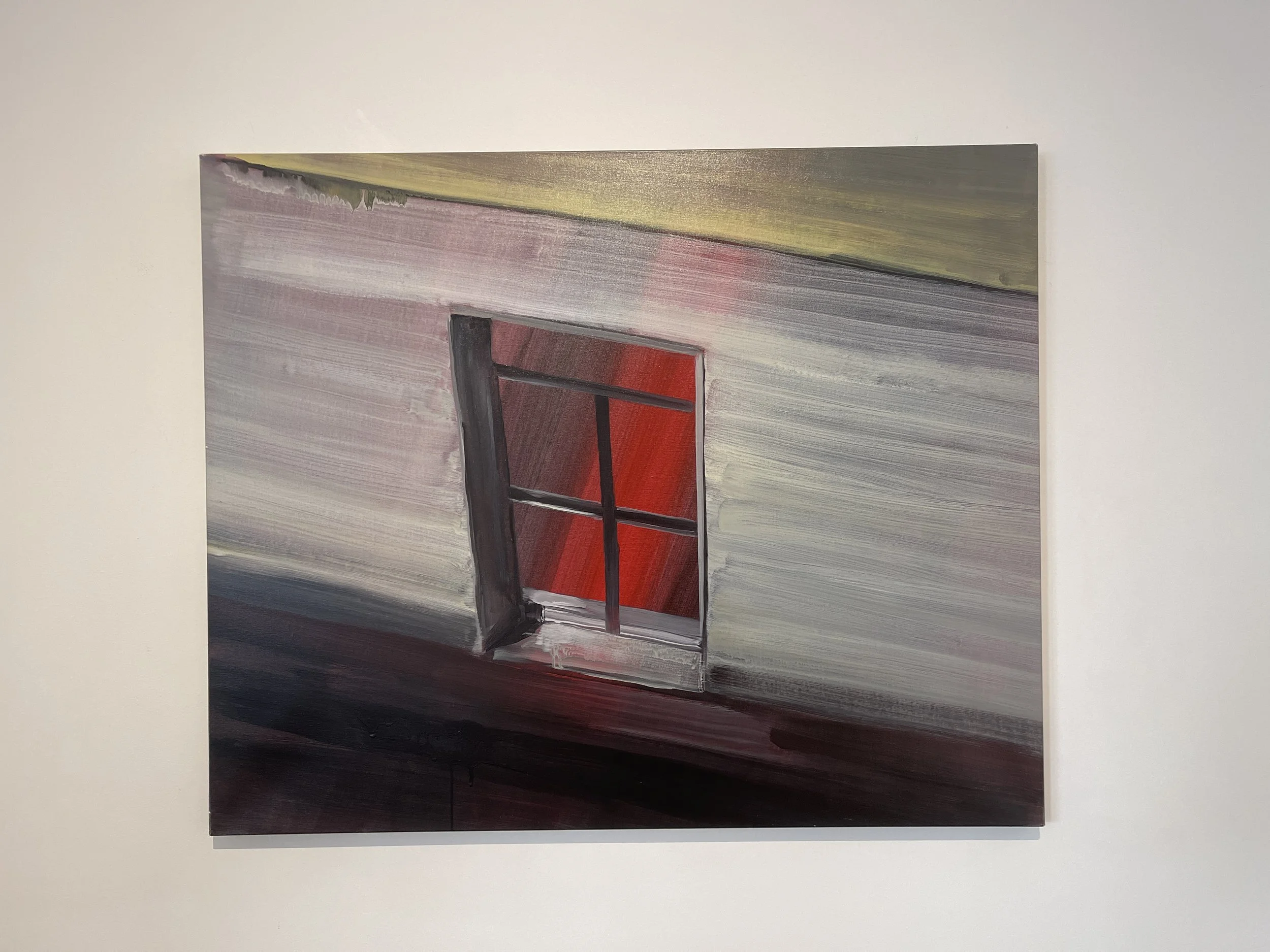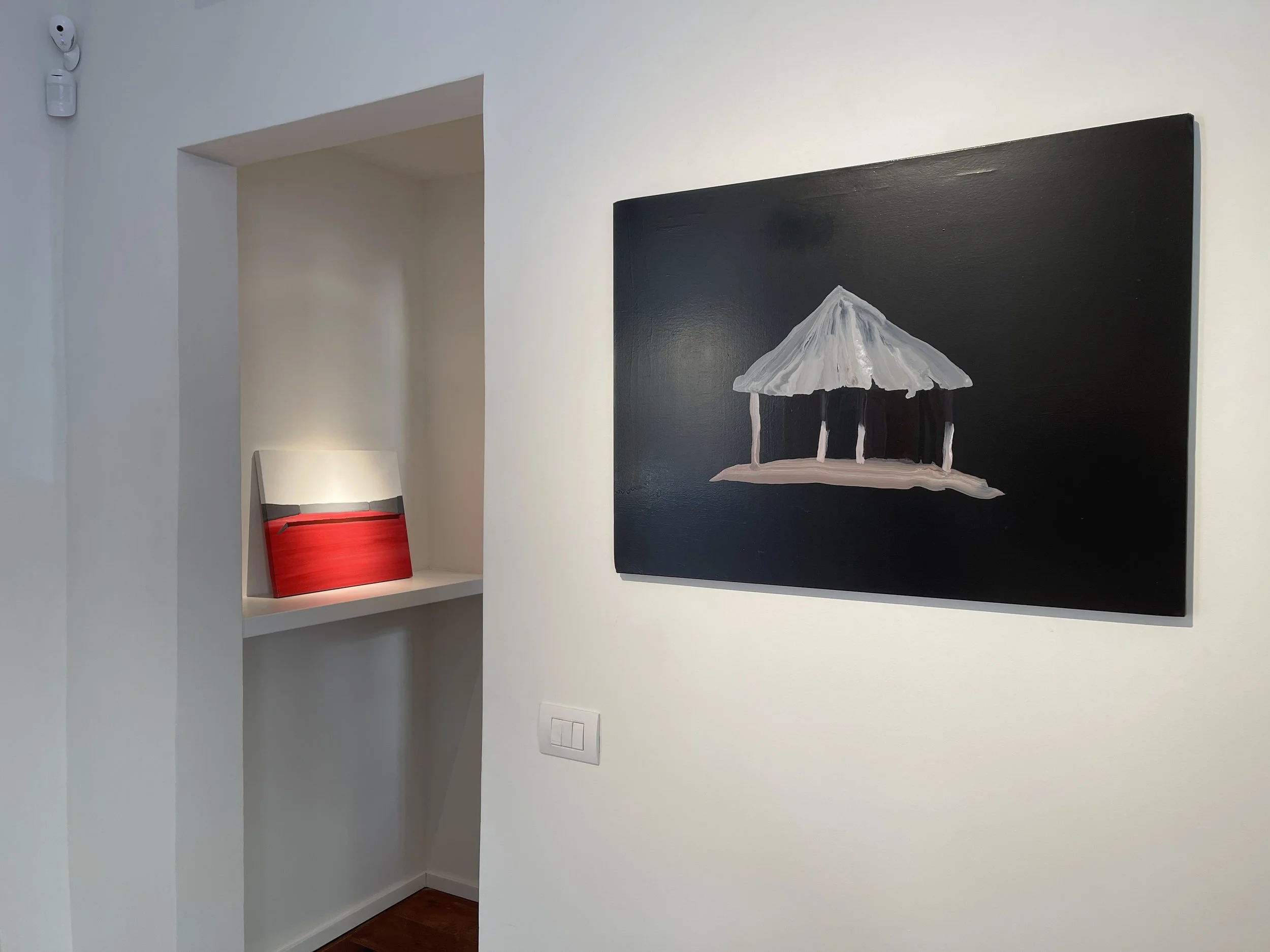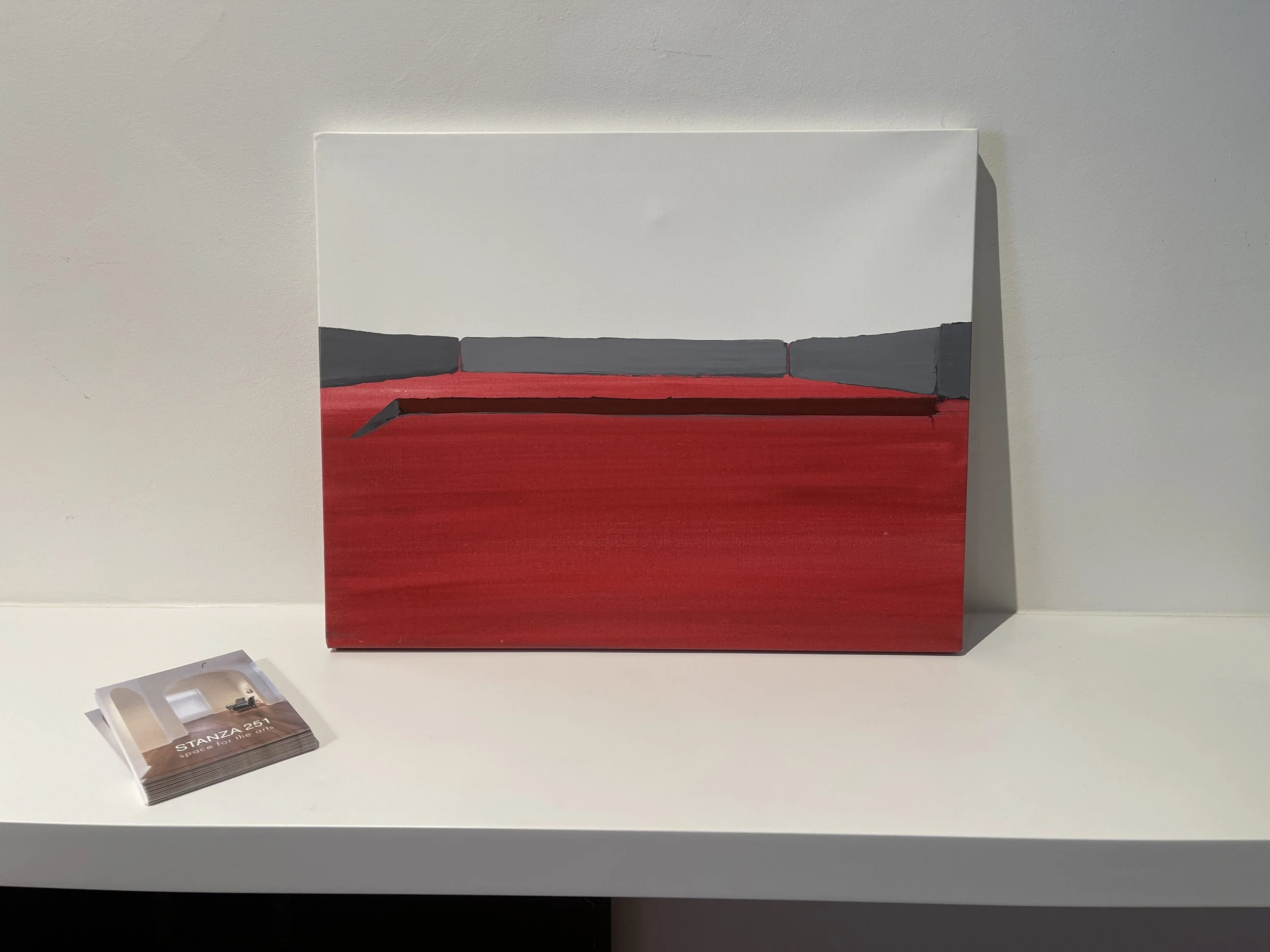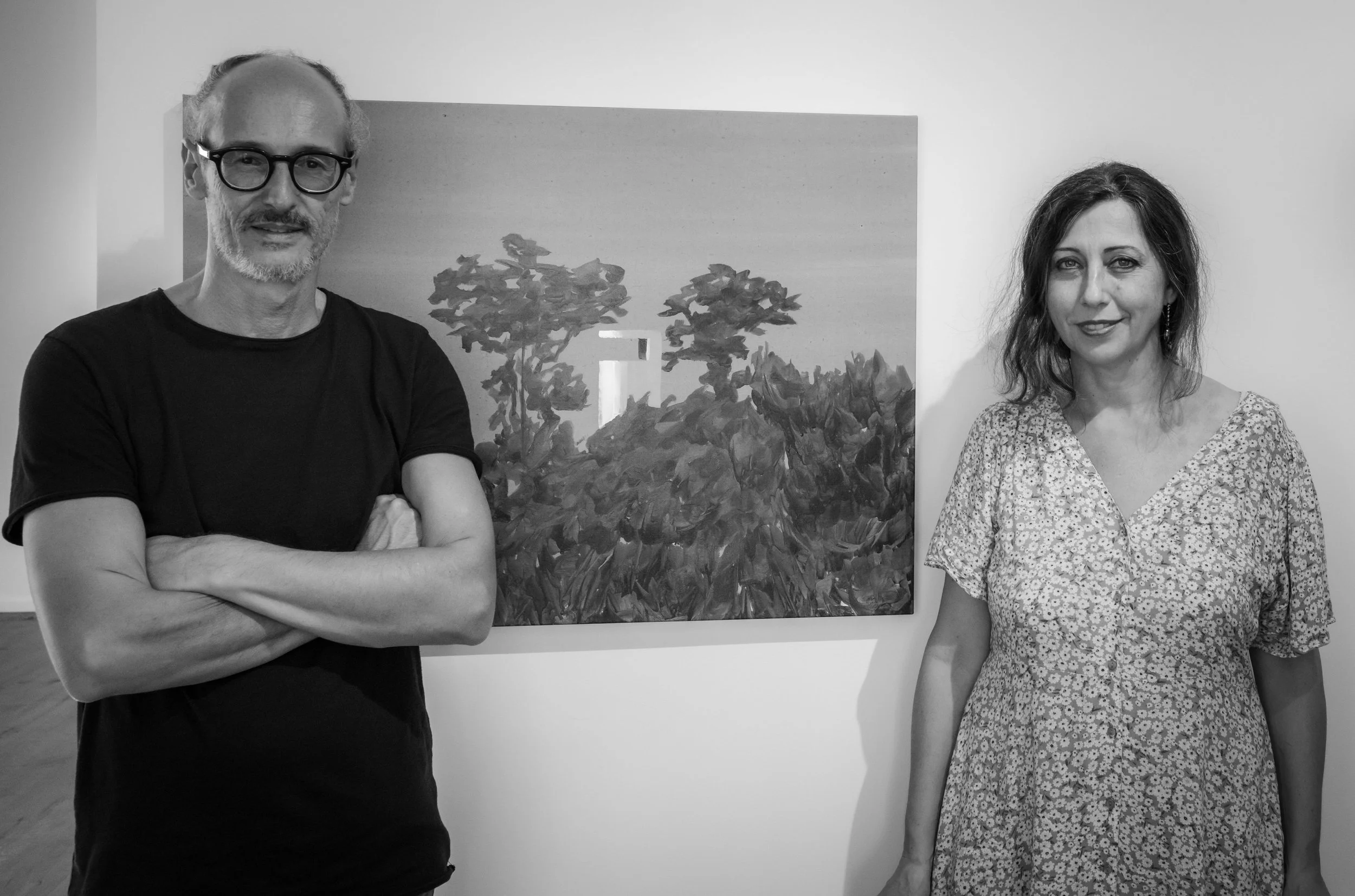Foschini/Iacomelli
Miraggi
Aprile - Giugno 2025
Angelo Foschini e Lavinia Iacomelli dipingono insieme opere che miracolosamente possiedono una precisa unità stilistica, una personalità, un marchio di fabbrica inconfondibile. Uno dei temi fondamentali del loro lavoro – ispirazione che si è mantenuta costante attraverso il tempo – è l'azione di abitare, con il conseguente oggetto privilegiato, la casa, declinato in molteplici forme. Di conseguenza trasportano su tela una serie di tipologie ben riconoscibili. la capanna primitiva, la misteriosa piramide, la palafitta, la villa moderna razionalista, una torre immersa nella foresta.
Sono situazioni allestite sempre con i minimi elementi strettamente necessari, senza orpelli di nessun genere, perché queste architetture devono trionfare al centro della scena come giocattoli esemplari (non a caso i colori usati spesso ricordano quelli dei mattoncini Lego). Strutture scheletriche si stagliano contro uno sfondo giallo impossibile, vediamo paesaggi fluidi in cui terra, cielo, vegetazione ed architetture sembrano fatti della stessa materia gommosa. Questo tipo di costruzione pittorica emana un avvolgente flusso allucinatorio. Le opere di Foschini/Iacomelli negano il realismo e finiscono per produrre una sorta di dimensione alternativa in cui quello che vediamo è un segnale ambiguo, una rappresentazione che allude al altri spessori più nascosti.
Stefano Loria
Angelo Foschini and Lavinia Iacomelli together paint works that miraculously possess a precise stylistic unity, a personality, an unmistakable trademark. One of the fundamental themes of their work - an inspiration that has remained constant through time - is the action of inhabiting, with the resulting privileged object, the house, declined in multiple forms. Consequently, they transport a series of clearly recognizable typologies onto canvas. the primitive hut, the mysterious pyramid, the pile dwelling, the modern rationalist villa, a tower immersed in the forest.
These are situations always set up with the strictly necessary minimum elements, without frills of any kind, because these architectures must triumph in the center of the scene as exemplary toys (it is no coincidence that the colors used often resemble those of Lego bricks). Skeletal structures stand out against an impossible yellow background, we see fluid landscapes in which earth, sky, vegetation and architecture seem to be made of the same rubbery material. This kind of pictorial construction exudes an enveloping hallucinatory flow. Foschini/Iacomelli's works deny realism and end up producing a kind of alternative dimension in which what we see is an ambiguous signal, a representation that alludes to other, more hidden thicknesses.
Stefano Loria
Tre domande a Foschini/Iacomelli
STANZA 251: Cominciamo da un tema che affrontate spesso nei vostri lavori: l'architettura. Dipingete capanne, casette isolate, roulotte, ville dall'aspetto modernista, antiche piramidi, le rampe di un misterioso scivolo da luna park acquatico. Tipologie molto differenti che sottoponete ad un trattamento sofisticato, in modo da creare oggetti esemplari, costruzioni isolate che acquistano la consistenza ambigua di un miraggio. Raccontateci questo vostro interesse per le architetture storiche e contemporanee, magicamente restituite dal regno del sogno al nostro sguardo.
FOSCHINI/IACOMELLI: L’architettura ha sempre rappresentato per noi un tema centrale, all’inizio del nostro percorso era il soggetto di sfondo, la presenza condizionante e a tratti necessaria alla caratterizzazione dei giovani personaggi che abitavano le tele. Nel passaggio attuale dei dipinti realizzati a smalto, l’architettura si è fatta protagonista assoluta di spazi sospesi tra la realtà e il filtro dello stupore. La materia scintillante dello smalto ha avvolto questi luoghi abitati e abitativi, immergendoli in una atemporalità che ci ha permesso di sondarne la forma. Questo nostro interesse è nato inizialmente dalla mappatura degli edifici dell’architettura popolare del secolo scorso, luoghi dell’infanzia e della memoria, luoghi vissuti amati o odiati, ma indelebilmente osservati e condivisi, edifici, villette, parchi di cemento tagliati dal sole, metafisicamente metabolizzati e digeriti senza risposta, oggetti fatti di dimensioni, elementi e scale, in cui immaginare di entrare, uscire, sostare, vivere. Nella serie delle capanne ci siamo chiesti quali fossero gli elementi essenziali che potessero definire visivamente un concetto di casa e ci siamo spinti a restituirli sintetizzando l’estetica di luoghi del vissuto in senso più ampio, come prefabbricati, roulotte o forme simili a giganteschi templi.
STANZA 251: Un altro soggetto che sembra costantemente al centro della vostra ispirazione è il paesaggio naturale. Però lo elaborate secondo modalità anti-realistiche: evidentemente la vostra idea non è quella di documentare un bosco o la superficie di un lago in modo esatto, Mettete in scena sempre uno scarto visivo che rende la scena irreale, creando una atmosfera inquietante perché gli elementi del paesaggio finiscono per suggerire incertezza ed una fragilità quasi soprannaturali.
FOSCHINI/IACOMELLI: Nella ricerca sul paesaggio cerchiamo di innestare o evidenziare un punto di rottura, un elemento reale o fantastico che porti la scena di partenza altrove; è il nostro modo per spostare la riflessione lontano dal dato visibile e ampliare le possibilità concettuali dell’immagine. L’obiettivo è quasi sempre quello di esortare ad accorgersi di quello che c’è di fronte ai nostri occhi attraverso ciò che non c’è veramente, non è mai stato lì, non dovrebbe o potrebbe essere in quel luogo. Non ha però la finitezza surrealista del definirsi in un contesto con dei meccanismi sognati, scaturisce piuttosto da una forzatura del dato reale di partenza che manipoliamo fino a minare la struttura del tutto. Spesso i paesaggi da cui prendiamo spunto fanno parte dell’urbano periferico o al contrario, dell’iconicamente abusato. Rimodellare le forme e i contesti del flusso quotidiano, del banale, del solito, ci permette di usare un tipo di estetica già presente, con una sorta di atteggiamento anticonsumistico, qualcosa che ci fa continuamente riflettere su quanto nutrimento visivo abbiamo a disposizione dove non sembra esserci. Attraverso un piccolo sforzo immaginativo è possibile suggerire “città invisibili”, basate sulle necessità umane di sopravvivenza e conservazione, fino a spingerci a riflettere su quanto abbiamo da preservare da ogni distruzione.
STANZA 251: La rappresentazione della figura umana all'inizio della vostra attività era collocata in un raggio d'azione tra un netto realismo ed una moderata accentuazione delle forme di stampo espressionistico. Successivamente avete cambiato registro, trattando i corpi in modo molto efficace, con deformazioni più estreme, quasi fantascientifiche, oppure inserendo queste figure in un contesto surreale, dentro una specie di realtà totalmente impossibile.
FOSCHINI/IACOMELLI: La figura ha sempre rappresentato per noi un luogo d’indagine, un retaggio visivo di formazione, e un’architettura essa stessa, a cui appellarsi strutturalmente per certificare la presenza naturale dell’essere umano nel flusso mai completamente chiuso e definito della realtà. Abbiamo inizialmente usato la tela come scacchiere e la figura come regina inconsapevole e solo apparentemente libera dai dettami della realtà architettonica da cui era circondata. Successivamente abbiamo rappresentato i personaggi delle nostre tele con formule espressioniste, incastonate nei luoghi da cui provenivano o che si erano andati a cercare, contribuendo alla realizzazione strutturale del contesto che animavano. Nelle serie recenti invece abbiamo optato per una figura che avesse la capacità e la necessità di intervenire sulla realtà circostante per plasmarla, per farsi elemento di costante partecipazione dello spazio della tela, e per scardinare alcune costrizioni della forma suggerendo una possibilità alternativa di vissuto, anche laddove non sembrava poterci essere.
Three Questions to Foschini/Iacomelli
STANZA 251: Let's start with a theme you often address in your work: architecture. You paint huts, isolated cottages, caravans, modernist-looking villas, ancient pyramids, the ramps of a mysterious water funfair slide. Very different typologies you subject to sophisticated treatment in order to create exemplary objects, isolated constructions that acquire the ambiguous texture of a mirage. Tell us about this interest of yours in historical and contemporary architecture, magically restored from the realm of dreams to our gaze.
FOSCHINI/IACOMELLI: Architecture has always been a central theme for us; at the beginning of our journey it was the background subject, the conditioning and at times necessary presence for the characterization of the young characters who inhabited the canvases. In the current passage of paintings made in enamel, architecture became the absolute protagonist of spaces suspended between reality and the filter of wonder. The shimmering material of enamel enveloped these inhabited and living places, immersing them in a timelessness that allowed us to probe their form. This interest of ours initially arose from the mapping of the buildings of popular architecture of the last century, places of childhood and memory, lived places loved or hated, but indelibly observed and shared, buildings, cottages, concrete parks cut by the sun, metaphysically metabolized and digested without response, objects made of dimensions, elements and scales, in which to imagine entering, exiting, stopping, living. In the series of huts, we asked ourselves what were the essential elements that could visually define a concept of home, and we went so far as to return them by synthesizing the aesthetics of places of living in a broader sense, such as prefabs, caravans, or shapes resembling giant temples.
STANZA 251: Another subject that seems constantly at the center of your inspiration is the natural landscape. However, you process it in anti-realistic ways: clearly your idea is not to document a forest or the surface of a lake exactly, You always stage a visual gap that makes the scene unreal, creating an eerie atmosphere because the landscape elements end up suggesting uncertainty and an almost supernatural fragility.
FOSCHINI/IACOMELLI: In landscape research, we try to graft or highlight a breaking point, a real or fantastic element that takes the source scene elsewhere; it is our way of shifting reflection away from the visible datum and expanding the conceptual possibilities of the image. The goal is almost always to urge us to notice what is in front of our eyes through what is not really there, was never there, should not or could not be there. It does not, however, have the surrealist finitude of defining itself in a context with dreamed mechanisms; rather, it springs from a forcing of the real starting datum that we manipulate to the point of undermining the structure of the whole. Often the landscapes from which we take our cues are part of the urban peripheral or conversely, the iconically abused. Reshaping the forms and contexts of the everyday flow, the mundane, the usual, allows us to use a kind of aesthetic that is already there, with a kind of anti-consumerist attitude, something that makes us continually reflect on how much visual nourishment we have available where there doesn't seem to be any. Through a little imaginative effort it is possible to suggest “invisible cities,” based on human needs for survival and preservation, to the point of prompting us to reflect on how much we have to preserve from all destruction.
STANZA 251: The representation of the human figure at the beginning of your activity was placed in a range between stark realism and a moderate accentuation of expressionistic forms. Later you changed the register, treating bodies very effectively, with more extreme, almost science fiction-like deformations, or placing these figures in a surreal context, within a kind of totally impossible reality.
FOSCHINI/IACOMELLI: For us, the figure has always represented a place of inquiry, a visual legacy of formation, and an architecture itself, to which we structurally appeal to certify the natural presence of the human being in the never completely closed and defined flow of reality. We initially used the canvas as a checkerboard and the figure as an unconscious queen, only seemingly free from the dictates of the architectural reality by which she was surrounded. Later, we represented the characters in our canvases with expressionist formulas, embedded in the places from which they came or sought out, contributing to the structural realization of the context they animated. In the recent series, on the other hand, we opted for a figure that had the ability and the need to intervene in the surrounding reality in order to shape it, to make itself an element of constant participation in the space of the canvas, and to unhinge some of the constrictions of the form by suggesting an alternative possibility of living, even where there seemed to be no possibility of it.
Angelo Foschini (1973) e Lavinia Iacomelli (1975), vivono e lavorano a Livorno. Laureati nel 2000 all’Accademia di Belle Arti di Carrara, lavorano insieme dal 2001 nell’ambito delle arti visive dipingendo ed esponendo in gallerie private e spazi pubblici. Affiancano alla loro produzione l’insegnamento delle arti visive nella scuola pubblica, e l’organizzazione di corsi e laboratori creativi per bambini e adulti in spazi privati. Dal 2001 al 2010 hanno lavorato ad un progetto pittorico comune realizzando opere a quattro mani, sotto il nome di Koroo. Hanno tenuto mostre personali e collettive in Italia e all’estero, collaborando con gallerie e partecipando a fiere d’arte contemporanea. Dal 2011 lavorano a progetti comuni utilizzando la firma Foschini/Iacomelli.
Angelo Foschini (1973) and Lavinia Iacomelli (1975) live and work in Livorno. Graduates in 2000 from the Academy of Fine Arts in Carrara, they have been working together since 2001 in the visual arts, painting and exhibiting in private galleries and public spaces. They combine their production with teaching visual arts in public schools, and organizing courses and creative workshops for children and adults in private spaces. From 2001 to 2010, they worked on a joint painting project making works by four hands, under the name Koroo. They have held solo and group exhibitions in Italy and abroad, collaborating with galleries and participating in contemporary art fairs. Since 2011 they have been working on joint projects using the Foschini/Iacomelli signature.
